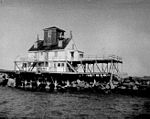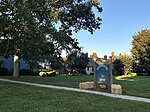Delaware Breakwater Range Rear Light
1881 establishments in Delaware1919 disestablishments in the United StatesBuildings and structures demolished in 1919Lighthouses completed in 1881Lighthouses in Sussex County, Delaware
The Delaware Breakwater Range Rear Light (also known as the Green Hill Light) was a lighthouse west of Lewes, Delaware. It was made obsolete by the shifting of Cape Henlopen and was disassembled and moved to Florida to become the Boca Grande Entrance Range Rear Light.
Excerpt from the Wikipedia article Delaware Breakwater Range Rear Light (License: CC BY-SA 3.0, Authors).Delaware Breakwater Range Rear Light
Pilottown Road,
Geographical coordinates (GPS) Address Nearby Places Show on map
Geographical coordinates (GPS)
| Latitude | Longitude |
|---|---|
| N 38.789722222222 ° | E -75.169444444444 ° |
Address
Pilottown Road
19958
Delaware, United States
Open on Google Maps










